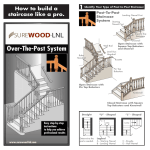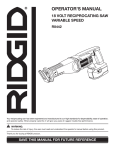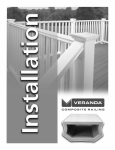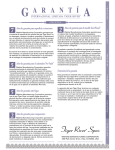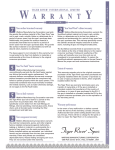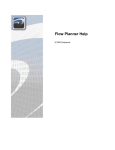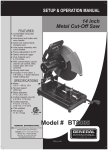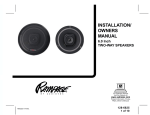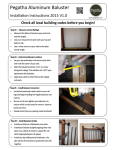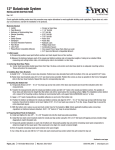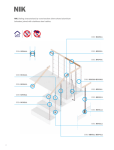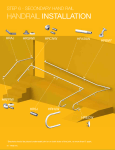Download Stair Parts I345D-000-HD58D Installation Guide
Transcript
How to build a staircase like a pro. 1 Identify Your Type of Post-to-Post Staircase: Post-To-Post Staircase System Starting Landing Newel Post Newel Post SUREWOOD LNL Square Top Balusters ~ Shoe rail Open Staircase with Square Top Balusters and Shoe rail Wall Rail Level Run Handrail Rake Handrail Rosette Pin Top Balusters Open Staircase with Pin Top Balusters Kneewall Closed Staircase with Square Top Balusters and Kneewall Straight SOM300113 Effective 11/20/2006 Determine the parts needed. “U” - Shaped Legend A - Starting Newel B - Landing Newel “L” - Shaped C - Rosette D - Half Newel © 2013 SureWood-LNL All Right Reserved | p 1 2 Selecting Your Parts: 3 Post-to-Post Staircase Parts Checklist: There are several styles and options for your treads, risers, balusters and newel posts. Below are the most common. Other items are available by special order. Check with your store representative. Check local building codes to ensure compliance. All stair parts shown in this brochure are for interior use only. Treads - Select one tread for each step. Part number Quantity Selected Needed _______ _______ Balusters, Newel Posts, Handrails, and Shoe rails: Risers - Select one riser for each step. Select one more riser than treads per each staircase. _______ _______ Landing Tread - Select sufficient lineal footage for the entire balcony and width of stairs at each landing. _______ _______ Return Nosing - If stair is open on one side, select one tread return nosing per step. If two-sided, select two per step. _______ _______ Starting Newel* - Use at the bottom of the staircase. _______ _______ Landing Newel* - Use at the landing corner of an L-shaped stair and at the second floor landing. _______ _______ Square Top Baluster: Pin Top Baluster: Pin top balusters used with solid handrail. 6010 Solid handrail A 6045 Shoe rail 1-1/4’’ 6010 Plowed handrail B A Level Run Newel* - If the balcony is 10 feet or longer, use a newel every 5 or 6 feet. Place a newel at every corner. The Landing Newel may be used, but be sure to match the top block with the newel used at the top of the stairway for consistency. _______ _______ B Starting Newel 48’’ Landing Pin Top Square Starting Top Newel Baluster Newel Baluster 59’’ 48’’ Starting Newel 54’’ Treads and Risers: 3503-BT 3500-BT54 3500-BT 5205 5015 4015-BT 4012-BT* 4010-BT Rosette or Half Newel - Select either a rosette or half newel _______ _______ for each handrail connecting to a wall. Starting Newel 54’’ Landing Newel 54’’ Wall Rails and Handrail Ends: Tread 6042 Wall Rail Riser 7009 Returned End 7011 Quarter-Turn Wall Rail Brackets: 8080 Tread Return Nosing 8090 Landing Tread Mounting Hardware: Rail Bolt Newel Attach Kits (Oak, Poplar, Hemlock) Wood Plugs Rail Joinery Made Simple! Spring Bolt™ Rail to Rail Kit C Rosettes: D Half Newel: Round Rosette Oval Rosette For Wall Finishing Half newels available to match newel style. Newel Mounting Hardware - Select one newel mounting kit _______ _______ for each newel post mounted on top of a tread. Rake Balusters* - Select the 34“ baluster for the front baluster on each tread and the 36“ baluster for the back baluster on each tread. If using 3 balusters per tread, use the 36“ baluster for the middle baluster on each tread. _______ _______ Rake Balusters for Kneewall Staircase* - Select the 34“ baluster at a rate of 2 per tread. Standard placement is 4”on center. Check local building code for your area. _______ _______ Level Run Balusters* - Use the 36“ baluster for all 36“ height balconies and the 41“ baluster for all 41“ height balconies. Standard placement is 4”on center. Check local building code for _______ _______ your area. Handrail - Buy 13“ of handrail for each tread or step. Buy enough for all level runs. _______ _______ Shoe rail for Rake - Buy 13” of corresponding shoe rail for each tread or step (shoe rail or kneewall stairs only). _______ _______ Shoe rail for Balcony (optional) - Buy enough to cover all Level Runs. _______ _______ Plugs -Select two wood plugs for every newel mounting using lag bolts. Select one plug for each handrail rail bolt used. Select one plug for every handrail or shoe rail mounting using a lag _______ _______ bolt or wood screw. *Note: These guidelines are for a rake handrail height of 36“– 41“. Longer newels and balusters may be required for a different handrail height. © 2013 SureWood-LNL All Right Reserved | p 2 4 6 Tools Required: Operation: Tools Needed: Measuring and Leveling Metal measuring tape, hand levels, (torpedo and 4’ level), framing square Cutting Miter box and saw (fine-tooth) hand or power circular saw or standard hand saw Nailing Hammer, nail set, 1/2“ and 1“ finishing nails Gluing Carpenter’s glue and construction adhesive Screw Driving Screwdriver (manual or power), 3“ wood screws Drilling Hand drill, drill guide and 1/8“, 1/4“, 3/8“, 5/8“, 3/4“, 1“ wood bits Finishing Sandpaper, steel wool, wood file, wood chisel, finishing stain, rags, tack cloth, etc. 5 Basic Layout and Newel Post Installation: Marking Your Staircase for Installation Landing Newel Height A) Height of the handrail should be between 36“ and 42”. Check local building codes. B) Place the top of the handrail one inch below the top block of the newel. Tread Return Nosing With newel in position where it is to be mounted, slide short end of framing square along slope of stairway. Baluster B) Measure down 1” from Centerline top of newel square. Make Face of Stringer mark. Mark Position of Baluster Centerpoint C) The difference between Starting Newel the two marks “A”and “B” is what will be cut off bottom of newel. Proceed with newel installation. Landing Tread Landing Tread B C A) Slide into post as shown. Make mark. B Landing tread can be used with 3/4”oak flooring along a landing when solid oak treads and risers are used. Landing tread can be used along a balcony with oak flooring. Properly cut miters and attach directly to sub floor. A Mark Position of Landing Newel and Centerline To properly install solid oak treads and risers, you must first remove the existing steps to expose the rough framing. Leave the beginning riser at base of steps (A). Measure and cut each step separately to ensure tight fit. (B). Pre-drill, apply construction adhesive and nail into place. For added strength, screw treads to risers from behind (C). Complete each step before continuing on to next step. C 1’’ Layout your staircase directly on your treads and landings. Carefully mark Newel and Baluster positions and centerlines. Getting Started - Tread and Riser Installation: A Starting Newel Height A B 1’’ from top of square part of newel 36’’ to 42’’ above front of tread Check local building codes for proper handrail height. Newel Post Attachment Trim and Fasten the Newel Posts Tread Tread Return Nosing Installation Cut and miter tread return nosing to fit. Adds a finished look to the tread edge. Tread Return Nosing Bracket with Molding Wood Plugs Lag Bolts © 2013 SureWood-LNL All Right Reserved | p 3 7a Attaching Handrail for Pin Top Balusters: Pin top are installed first on the staircase and then the handrail is lowered down onto them. 7b Attaching Handrail for Square Top Balusters: Square top balusters are installed after the bottom shoe rail and plowed handrail are installed. A) Mark baluster placement on treads allowing for equal spacing. Drill treads the same size and depth as pin on bottom of baluster. Mark and Cut Here A A) Lay handrail and shoe rail along stairs, marking where they intersect with newels. Place rail on side and cut along marks. A B) Attach handrail using option #1 (3”wood screws) or option #2 (4-1/2” lag bolts through front of rail). Both options require pre-drilling a pilot hole. Attach shoe rail using option #1 (3”wood screws), option #2 (toe-nailed finishing nails) or option #3 (screwed to kneewall). Handrail B) Lay handrail along stairs allowing extra length for proper fit to newels. Using framing square, transfer tread markings to side of handrail. Transfer markings to bottom center of handrail. B B 1 C Mark Handrail Here E) Using newels as guide, mark handrail and cut to proper length. Follow instructions for attaching newels. BALCONY Balcony end of handrail Mark and Cut Here Lag Bolt Wood Screws C For balconies, follow same procedures, keeping handrail on flat surface when drilling. Countersunk Wood Screws 2 Wood Plug C) Locate baluster holes in solid handrail. Mark center of handrail D) Rotate handrail 180 ° on stairs so balcony side of handrail is at base of stairs. Drill holes using 5/8” drill bit a minimum of 3/4”deep into handrail. Use drill guide set to proper angle D Shoe rail C) Use an D adjustable square to determine the angle of the cut; allow for 1/4” plow depth on each handrail and shoe rail. Wood Plug Toe-nailed Finishing Nails Screwed to Kneewall 3 2 1 D) Cut E balusters to the correct length. Once spacing is determined, glue and toenail balusters into place. E )Cut fillet pieces being sure to match angles. Glue and nail into place using 1/2” finishing nails. *Most codes require 4”on center spacing. Check your local municipality for all applicable building codes. 8 Finish to Wall and Wall Rail Installation: Wall Rail Styles: E 6042 Wall Rail with bracket Attach rosette or half newel directly to handrail as shown. Secure first to handrail using nails or screws, then secure to wall. 6010-S Handrail w/ 7011 Quarterturn 6010-S Handrail w/ 7009 Returned End © 2013 SureWood-LNL All Right Reserved | p 4 How to build a staircase like a pro. 1 Identify Your Type of Over-The-Post Staircase: Over-The-Post Staircase Gooseneck System Turnout SUREWOOD LNL Pin Top Balusters ~ Radius End Starting Step Open Staircase with Turnout Starting Fitting Wall Rail Level Run Handrail Rake Handrail Rosette Volute Landing Newel Post Radius End Starting Step Open Staircase with Volute Starting Fitting Starting Easing Starting Newel Post Open Staircase with Starting Easing Fitting Straight Determine the parts needed. “U” - Shaped Legend A - Starting Newel B - Landing Newel C- Rosette “L” - Shaped D - Straight Gooseneck E - 90˚ Gooseneck F - 180˚ Gooseneck G - Staring Fitting © 2013 SureWood-LNL All Right Reserved | p 5 2 Selecting Your Parts: 3 Post-to-Post Staircase Parts Checklist: There are several styles and options for your treads, risers, balusters and newel posts. Below are the most common. Other items are available by special order. Check with your store representative. Check local building codes to ensure compliance. All stair parts shown in this brochure are for interior use only. Treads - Select one tread for each step. Part number Quantity Selected Needed _______ _______ Balusters, Newel Posts: Risers - Select one riser for each step (except the starting step). Select one more riser than treads per each staircase. _______ _______ Landing Tread - Select sufficient lineal footage for the entire balcony and width of stairs at each landing. _______ _______ For Wall Finishing used to connect Handrail to Wall Return Nosing - If stair is open on one side, select one tread return nosing per step. If two-sided, select two per step. _______ _______ Mounting Hardware: Starting Fitting - Select either a Volute, Turnout, or Starting Easing. _______ _______ Starting or Landing Newel* - Use at the bottom of the stairway and at the second floor landing. If the balcony is 10 feet or longer, use the starting newel every 5 or 6 ft. Place a newel at every corner under a quarterturn. _______ _______ Intermediate Landing Newel* - Use at the intermediate landing corner of a U-or L-shaped stair. _______ _______ Rosette - Select a rosette for each handrail connection into a wall. _______ _______ Newel Mounting Hardware: - Select one newel mounting kit for each newel post mounted on top of a tread. _______ _______ Balusters for Starting Fittings* - Each volute requires (6)1-1/4“ x 41“ balusters, or (4)1-1/4 or 1-3/4“ x 41“ balusters. Each turnout requires (2)1-1/4“ x 41“ balusters or (1)1-3/4“ x 41“ baluster. Each starting easing requires (1) 41“ baluster. _______ _______ Rake Balusters* - Select the 34“ baluster for the front baluster on each tread and the 36“ baluster for the back baluster on each tread. If using 3 balusters per tread, use the 36“ baluster for the middle baluster on each tread. _______ _______ Level Run Balusters* - Use the 36“ baluster for all 36“ height balconies and the 41“ baluster for all 41“ height balconies. Standard placement is 4“ on center. Check local building code for your area. _______ _______ Handrail - Buy 13“ of handrail for each tread or step. Buy enough for all level runs. _______ _______ Plugs - Select two wood plugs for every newel mounting using lag bolts. Select one plug for each handrail rail bolt used. _______ _______ Handrail Mounting Hardware - Select one Rail Bolt Kit or Spring Bolt for each handrail-to-handrail connection required. _______ _______ Gooseneck Fittings - Select the appropriate gooseneck fitting for each straight, U or L-shaped staircase newel. _______ _______ B C Rosettes: Pin Top Balusters Use and Intermediate Landing Newel at all landings. Each newel must be covered with a fitting Oval Rosette 3503-BT Use with a Starting Fitting at the beginning of a staircase. Also use on a level run of a handrail with a fitting. 3500-BT 5015 (used with solid handrail) A Starting Newel Post Rail Bolt Landing Newel Post Newel Attach Kits (Oak, Poplar, Hemlock) Treads and Risers: Tread Landing Tread Riser Tread Return Nosing Handrail, Ends and Wall Rails: Wall Rails Brackets: 7009 7011 Returned End Quarterturn 6042 Wall Rail Choose Fitting Style: Tandem Cap 7009 7021 Opening Cap No Cap 7020 7019 With Cap Quarterturn With Cap Returned End 7011 6010 Solid Handrail Returned End Eb 7021 7020 Returned End Quarterturn With Cap Tandem Cap F G 7098 Straight Ea 7012 D 7011 Make Gooseneck transition using these parts: Up-easing Rail Joinery Made Simple! Riser No Cap Spring Bolt™ Rail to Rail Kit Each pin top newel post must be covered with a fitting. The floor plans to the left illustrate the fitting components needed for each landing situation. Choose Starting Fitting: Up-easing Use at the bottom of the stairway over the Starting Newel. Volutes and Turnouts are available left hand or right hand. 7019 Build a Starting Easing 7045 Right Hand Turnout 7040 Left Hand Turnout 7012 7035 Right Hand Volute 7030 Left Hand Volute Opening Cap *Note: These guidelines are for a rake handrail height of 36“– 41“. Longer newels and balusters may be required for a different handrail height. © 2013 SureWood-LNL All Right Reserved | p 6 4 6 Tools Required: Operation: Tools Needed: Measuring and Leveling Metal measuring tape, hand levels, (torpedo and 4’ level), framing square Cutting Miter box and saw (fine-tooth) hand or power circular saw or standard hand saw Nailing Hammer, nail set, 1“ finishing nails Gluing Carpenter’s glue and construction adhesive Screw Driving Screwdriver (manual or power), 3“ wood screws Drilling Hand drill, drill guide and 1/8“, 1/4“, 3/8“, 5/8“, 3/4“, 1“ wood bits Finishing Sandpaper, steel wool, wood file, wood chisel, finishing stain, rags, tack cloth, etc. 5 Basic Installation: Marking Your Staircase for Installation Layout your staircase directly on your treads and landings. Carefully mark Newel and Baluster positions and centerlines. Mark Position of Landing Newel and Centerline Getting Started - Tread and Riser Installation: Baluster Centerline Face of Stringer Mark Position of Baluster Centerpoint To properly install solid oak treads and risers, you must first remove the existing steps to expose the rough framing. Leave the beginning riser at base of steps (A). Measure and cut each step separately to ensure tight fit. (B). Pre-drill, apply construction adhesive and nail into place. For added strength, screw treads to risers from behind (C). Complete each step before continuing on to next step. A B Starting Newel Volute Starting Fitting Layout C The balustrade centerline and newel centerpoints should be laid out. On a kneewall stair, the balustrade should be centered on the kneewall. On an open-tread stair, the centerline should be 1/2 of the baluster square in from the face of the stringer; i.e. 5/8“ for a 1-1/4’’ baluster. Landing Tread Landing Tread Landing tread can be used with 3/4”oak flooring along a landing when solid oak treads and risers are used. Landing tread can be used along a balcony with oak flooring. Properly cut miters and attach directly to sub floor. Tread Return Nosing Turnout Starting Fitting Layout Tread Tread Return Nosing Installation Cut and miter tread return nosing to fit. Adds a finished look to the tread edge. Tread Return Nosing Starting Easing Fitting Layout © 2013 SureWood-LNL All Right Reserved | p 7 7 9 Assemble the Handrail: Assemble the handrail on top of the stair treads prior to installing the newel posts. Use rail bolts and glue at each fitting connection. Complete intructions are included with fittings. Rail Bolt Installation Rail Bolt 2-1/8’’ Dia. Hole 8 3/8’’ Dia. Hole 15/16’’ A) Temporarily position assembled handrail onto newels. B) Use level to mark the handrail with baluster centers. A B C C) While handrail is on newels, drill baluster holes with drill guide. Drill holes using 5/8“ drill bit a minimum of 3/4“ deep into handrail. Apply glue to ends. Assemble and install nut. Tighten nut with wrench. Fill access hole with wood plug. 1/4’’ Dia. Hole Installing the Balusters and Handrail: 1’’ Dia. Hole 1-3/8’’ Dia. Hole D) Remove handrail from newels and drill baluster holes in treads. Glue and insert balusters. Toe-nail with 1“ finishing nails. D Attach rosette before installing handrail. E E) Apply glue to top of newels and balusters and attach handrail. Nut & Washer Newel Post Installation: Measure and Trim Newel Posts The rake rail height should be between 36”– 42” (H1) (check local building codes). Center the assembled handrail over the newel locations. Measure the distance between the tread and the bottom of the handrail fitting (A1 and A2). Also measure the rake rail thickness (T1). Use the following formula to calculate the starting newel height. H1 + A1 – T1 = Starting Newel Height 10 Finish to Wall and Wall Rail Installation: If the newel starts from the floor or a lower tread, add that distance as well. Newel Post Installation 36” to 41” above front edge of tread Wall Rail Styles: 6042 Wall Rail with bracket Bracket with molding Attach rosette rosette or half newel directly to handrail as shown. Wood Plugs 6010-S Handrail w/ 7011 Quarterturn 6010-S Handrail w/ 7009 Returned End Lag Bolts © 2013 SureWood-LNL All Right Reserved | p 8 Iron Baluster Installation IRON BALUSTER INSTALLATION GUIDE SUREWOOD LNL Before preceding with the following steps, the handrail height should already be determined. Read all the steps below before beginning installation. See “How-To Build a Staircase Like a Pro” for instructions on how to set proper handrail height. Over-the-Post Post-to-Post Wall Rail ~ Rake Handrail Wall Rail Level Run Handrail Rosette Level Run Handrail Rake Handrail Rosette Pin Top Balusters Landing Newel Post Radius End Starting Step Newel 1 Tread and Riser Installation: To properly install solid oak treads and risers, you must first remove the existing steps to expose the rough framing. Leave the beginning riser at base of steps (A). Measure and cut each step separately to ensure tight fit. (B). Pre-drill, apply construction adhesive and nail into place. For added strength, screw treads to risers from behind (C). Complete each step before continuing on to next step. A B Nosing Overhang equals the tread thickness C 2 Basic Layout: Marking Your Staircase for Installation Layout your staircase directly on your treads and landings. Carefully mark Newel and Baluster positions and center-lines. Post-to-Post Mark Position of Landing Newel and Center-line Baluster Center-line Face of Stringer Mark Position of Baluster Center-point* Starting Newel A “How-To” Guide for the Installation of Iron Balusters. *Metal balusters should be installed no wider than 4” on center, so that a 4” sphere cannot pass through anywhere along the handrail. Check your local building codes to ensure compliance. (Continued on next page) © 2013 SureWood-LNL All Right Reserved | p 9 2 Basic Layout (continued from last pg): Marking Your Staircase for Installation Layout your staircase directly on your treads and landings. Carefully mark Newel and Baluster positions and center-lines. 3 Newel Post Installation: Over-the-Post Assemble the Handrail: Rail Bolt Installation Apply glue to ends. Assemble and install nut. Tighten nut with wrench. Fill access hole with wood plug. Over-the-Post The balustrade center-line and newel center-points should be laid out. On a knee-wall stair, the balustrade should be centered on the knee-wall. On an open-tread stair, the center-line should be 1/2 of the baluster square in from the face of the stringer (i.e. 5/8” for a 1-1/4” baluster). Mark Position of Landing Newel and Center-line Baluster Center-line Face of Stringer Mark Position of Baluster Center-point* Starting Newel Turnout Starting Fitting Layout 1/4”Dia. Hole Assemble the handrail on top of the stair treads prior to installing the newel posts. Use rail bolts and glue at each fitting connection. Complete instructions are included with fittings. Starting Easing Fitting Layout Rail Bolt 2 1/8” 3/8” Dia. Hole 15/16” 1” Dia. Hole 1 3/8” Nut & Washer 3 Newel Post Installation: Post-to-Post Starting Newel Height With newel in position where it is to be mounted, slide short end of framing square along slope of stairway. A A) Slide into post as shown. Make mark. C 36” to 41” above front edge of tread B B) Measure down 1" from top of newel square. Make mark. C) The difference between the two marks "A" and "B" is what will be cut off bottom of newel. Proceed with newel installation. Landing Newel Height A) Height of the handrail should be between 36” and 42". Check local building codes. B) Place the top of the handrail one inch below the top block of the newel. A 36" to 42" above front of tread B 1" from top of square part of newel Measure and Trim Newel Posts *Check local building codes for proper handrail height. The rake rail height should be between 36”– 42” (H1) (check local building codes). Center the assembled handrail over the newel locations. Measure the distance between the tread and the bottom of the handrail fitting (A1 and A2). Also measure the rake rail thickness (T1). Use the following formula to calculate the starting newel height. H1 + A1 – T1 = Starting Newel Height If the newel starts from the floor or a lower tread, add that distance as well. Newel Post Attachment Trim and Fasten the Newel Posts using one of these methods Bracket with Molding Wood Plugs Lag Bolts 101 Sure-Tite Newel Fastener © 2013 SureWood-LNL All Right Reserved | p 10 4 Measure and Trim Balusters Mark baluster placement on treads allowing for equal spacing while following your original design. Drill holes* using 5/8" drill bit a minimum of 3/4" deep into stair treads. Make sure to keep the depths consistent. Using newels as guides, mark handrail and cut to proper length. Follow instructions for attaching newels and temporarily install handrail. Using a plum bob, line up with the holes in the treads and mark the handrail for the top of the baluster. Drill holes using 5/8" drill bit a minimum of 3/4" deep into handrail. Mark and Cut Here *Note: a. 1/2” balusters require 5/8” holes. b. 5/8” balusters require 7/8” holes. 5 Trim and Install Balusters Follow the instruction on the other side of this brochure to trim and install your Iron balusters. Replacing Wood Balusters with Iron Balusters Choose your look ... 3 Balusters per step* 2 Balusters per step* Single Basket Baluster Double Basket Baluster Rake Shoe Single Twist Baluster Double Twist Baluster Flat Shoe *Note: Building codes vary by municipality. Check with your local authorities to ensure your project meets code in your area. © 2013 SureWood-LNL All Right Reserved | p 11 Two Methods for Removing Old Balusters: 1st Method: 1. A firm twist of the baluster may be all that is necessary to remove baluster from tread and handrail. Remove any nails remaining or fasteners. 2. Once loosened, lift the baluster up into the handrail, enough to clear the stair tread at the bottom, and then tilt it to the side and pull out from the handrail. 3. If glue and/or wood still remains in the holes, a drill with a 1/2” bit can be used to remove any excess.* Installing New Balusters: Trim Iron Balusters to fit. 1. Using a metal tape measure, measure the distance from the front hole in the stair tread to the corresponding hole in the bottom of the handrail. It may be necessary to drill the hole deeper into the handrail to accommodate the baluster. Be careful to NOT drill through top of handrail. 2. Do this same procedure for the all holes in the stair tread. 3. To each of these measurements add 11/2”. Example: 35” + 11/2” = 36 -1/2” This is your baluster length. 2nd Method 1. Cut baluster in half with a hand or power saw. 2. Twist each half to loosen. 3. Remove each half of the baluster from the stair tread and handrail, and any nails remaining or fasteners. 4. If glue and/or wood still remains in the holes, a drill with a 1/2” bit can be used to remove any excess.* *Note: a. 1/2” balusters require 5/8” holes. b. 5/8” balusters require 7/8” holes. Trim and discard this section 35” The measurement from the top of the stair tread to the bottom of the handrail. Add 1½” 36½” This is the length to which you trim the baluster. 4. Using the above measurement, cut the baluster to the length needed. Be sure to cut from the bottom of your baluster. The top is the end with the rounded tip. Baluster Top 5. A Chop Saw with a metalcutting blade is the preferred way to cut the iron balusters. Take care when marking and cutting the balusters. Use safety glasses and follow proper safety precautions while cutting balusters. Note: Iron can be extremely hot after cutting. © 2013 SureWood-LNL All Right Reserved | p 12 Install and Secure Balusters 6. Before placing the balusters in the staircase, top and bottom “shoes” must be inserted on both ends. Loosen set Rake screws to insert baluster Shoe ends. Face set screws in same direction. 7. A RAKE shoe should be placed at the top (Pin end) of each baluster. A FLAT shoe Flat will go at the cut end of each Shoe baluster. Tighten in place a few inches from each end. This keeps them secure during placement of the baluster. 8. Make sure the “rake” of the shoe coincides with the angle of the handrail. The angle of the rake shoes may have to be adjusted with a grinder or belt sander for the best fit. Rake TIP: Test-fit all balusters before securing with epoxy. 9. Following manufacturers instructions, place epoxy in the stair tread hole and some on the Pin Top of the baluster. 10. Place the Pin Top into the handrail hole first and then into the stair tread hole. Straighten baluster once inserted. The Pin Top should press firmly against the front of the handrail hole,making sure that the flat shoe at the bottom squares up with the front of the step. 11. Once the epoxy has set, the rake and flat shoes can be put into position and secured with an allen wrench. © 2013 SureWood-LNL All Right Reserved | p 13













